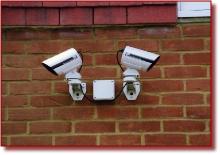![]()
![]()
![]()
![]()
![]()
![]()
![]()
![]()
![]()
![]()
![]()
![]()
![]()
![]()
![]()
![]()
![]()
![]()
![]()
![]()
![]()
![]()
![]()
![]()
![]()
![]()
![]()
![]()
![]()
![]()
![]()
![]()
![]()
![]()
![]()
![]()
![]()
![]()
![]()
![]()
IMPORTANT: No material may be reproduced, copied or redistributed from this site, without the express written consent of doktorjon.co.uk
All the detailed information on this site is provided in good faith; and as such, Doktor Jon does not accept responsibility for any consequential loss, injury or disadvantage resulting from any individual or organisation acting on the details contained herein.
© doktorjon.com 2004 - 2010
![]()

So what are the CCTV equipment options?
For Home use, there are effectively 2 types of CCTV equipment which are used in differing situations.
The basic 'domestic' grade of cameras, are generally constructed around a very low cost Printed Circuit Board or PCB camera (more information on these and others in the Camera Section).
Please Note - Doktor Jon is currently upgrading his site, so you may see some layout changes on various pages, whilst the work is in progress.
Hopefully, the complete re-design and improvements, should be completed by early 2010.
This type are mostly fitted with very basic performance fixed lenses, and are really only suitable for producing wide angle general views, or alternatively identifying individuals at relatively close range (depending on the picture quality, up to a max. of 20 - 30' or 6 - 10 m.); they are widely available 'over the counter' from larger homeware and DIY superstores or 'sheds'.
Whilst they are really produced down to a price, their technical performance can best be described as adequate for most situations, rather than exceptional.
In most cases, the PCB module is located inside a sealed environmental housing - be careful though ... not all are totally weatherproof, so it's best to check it's suitability for your preferred location, before you actually commit yourself to buying it - if you look for a 'weatherproof rating', anything below IP 55 is not really man enough to use in a location that will be subject to pouring rain or settling snow.
These basic grade models are really intended to be used as 'plug and play' devices, with no user settings to worry about. They're cheap, reasonably durable, not enormously high quality, but for low end applications like door monitoring or covering a small patio, they're normally ok provided of course there is sufficient lighting.
The down side of these cheap cameras, is that without being able to 'optimise' the choice of lens or exposure settings, they will generally produce a reasonable 'compromise' picture under most conditions, but it may not be what you actually need.
The major mistake that most people make when installing CCTV cameras, is that they try and cover a huge area, and are then amazed that anyone caught on the recording, cannot be identified "beyond reasonable doubt". In many cases, you're lucky if you can say that the blob on screen is even human!!
For looking at someone standing at a door, basic domestic cameras are usually fine, but to monitor larger areas such as for example a 100' (30 metre) driveway or large rear garden, they would not be the ideal choice.
There are a number of low cost varients, such as 'bullet' cameras (see photo above), some of which are fitted with Infra Red diodes for producing pictures in the dark, but again, their effective range is often somewhat limited, and you cannot normally use alternative lenses. Be aware that in most cases, 'bullet' cameras fitted with Infra Red diodes will glow red at night, which does not make them suitable for covert use. (if you're concerned about how bright the LED's glow, 815nM will be dull red and longer range, whereas 915nM is completely invisible, but generally much shorter range).
It's also worth mentioning that the specification quoted on many bullet cameras is somewhat optimistic to put it mildly - so if you do decide to go this route, buyer beware!
For a small property or basic application, these cameras and their supporting ancillary equipment, may well do the job; however, in more demanding situations, there really is no alternative but to use proper industrial grade CCTV equipment.
The next steps in using CCTV in the home >>>






